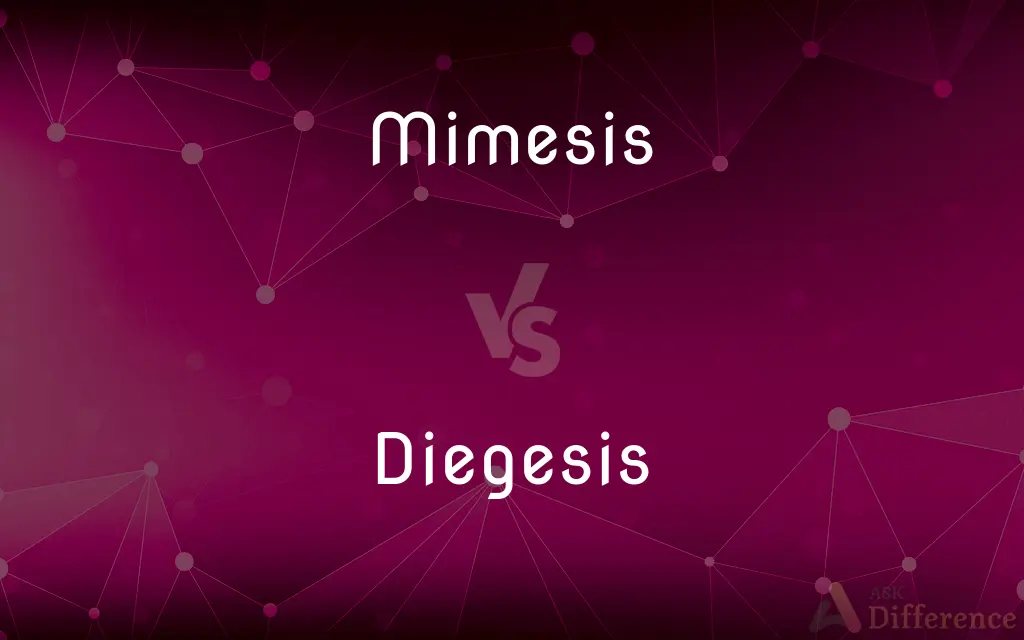Mimesis vs. Diegesis — What's the Difference?
By Tayyaba Rehman & Urooj Arif — Updated on April 7, 2024
Mimesis represents the direct imitation or representation of reality in art, while diegesis involves a narrative told rather than shown.

Difference Between Mimesis and Diegesis
Table of Contents
ADVERTISEMENT
Key Differences
Mimesis is a concept that refers to the imitation or representation of aspects of the real world in art and literature, emphasizing a direct and often realistic portrayal. This approach seeks to "show" rather than "tell," engaging the audience through a sensory experience that mirrors reality. Diegesis, on the other hand, involves the telling of a story by a narrator, where the elements of the story are not directly shown but rather described. This narrative technique focuses on the conveyance of a story through telling, offering a layer of interpretation or commentary on the events being described.
While mimesis involves the audience directly through sensory engagement, creating an experience that closely mimics real life, diegesis provides a more detached perspective. Diegesis allows for a broader exploration of thoughts, backgrounds, and motivations beyond what can be directly observed, offering insights into the internal lives of characters and the context of the narrative.
The distinction between mimesis and diegesis is crucial in understanding different artistic and literary techniques. Mimesis appeals to the audience's senses and emotions by replicating experiences, whereas diegesis engages the audience's imagination and intellect through storytelling and narration.
Despite their differences, both mimesis and diegesis play important roles in the creation and interpretation of art and literature. They offer diverse ways for artists and writers to convey messages, evoke emotions, and reflect on the human condition, demonstrating the richness and complexity of artistic expression.
Comparison Chart
Definition
Imitation of reality in art
Narrative told by a narrator
ADVERTISEMENT
Mode of presentation
Direct representation ("showing")
Indirect storytelling ("telling")
Engagement with audience
Sensory experience, direct involvement
Intellectual engagement, imaginative involvement
Examples
Plays, realistic paintings
Novels, narrative films
Focus
External, observable actions and appearances
Internal thoughts, historical context, motivations
Compare with Definitions
Mimesis
Aesthetic representation that mirrors actual experiences.
A film that uses special effects to realistically depict outer space provides an experience of mimesis.
Diegesis
Storytelling that involves a narrator’s commentary or description.
A documentary where the filmmaker narrates over the footage employs diegesis.
Mimesis
The artistic principle of exact imitation of life forms and experiences.
A sculpture that accurately embodies human anatomy showcases mimesis.
Diegesis
The universe in which a story takes place, including events not shown.
The backstory of a character that is revealed through the narrator’s account contributes to the diegesis.
Mimesis
The act of directly replicating aspects of reality in performance arts.
A theater production that uses realistic sets and costumes to replicate a historical event demonstrates mimesis.
Diegesis
The conveyance of a story by telling, rather than by direct demonstration.
An audiobook where the reader is guided through the plot by the narrator’s voice uses diegesis.
Mimesis
The technique of making art or literature reflect the physical world.
A novel that describes scenes in vivid detail, allowing readers to visualize the setting accurately, employs mimesis.
Diegesis
The narrative or story as told by a narrator.
A novel where the narrator describes the protagonist’s thoughts and actions is an example of diegesis.
Mimesis
Imitation of real-life scenarios in art.
A portrait capturing the intricate details of a person’s face is an example of mimesis.
Diegesis
The aspect of a narrative that includes all the events related by the narrator.
The detailed history of a fictional world as explained by the author or a character is part of the diegesis.
Mimesis
Mimesis (; Ancient Greek: μίμησις, mīmēsis) is a term used in literary criticism and philosophy that carries a wide range of meanings, including imitatio, imitation, nonsensuous similarity, receptivity, representation, mimicry, the act of expression, the act of resembling, and the presentation of the self.The original Ancient Greek term mīmēsis (μίμησις) derives from mīmeisthai (μιμεῖσθαι, 'to imitate'), itself coming from mimos (μῖμος, 'imitator, actor'). In ancient Greece, mīmēsis was an idea that governed the creation of works of art, in particular, with correspondence to the physical world understood as a model for beauty, truth, and the good.
Diegesis
Diegesis (; from the Greek διήγησις from διηγεῖσθαι, "to narrate") is a style of fiction storytelling that presents an interior view of a world in which: Details about the world itself and the experiences of its characters are revealed explicitly through narrative. The story is told or recounted, as opposed to shown or enacted.
Mimesis
The imitation or representation of aspects of the sensible world, especially human actions, in literature and art.
Diegesis
The presentation of a narrative without direct dramatic imitation of the events, scenes, or characters described.
Mimesis
(Biology) Mimicry.
Diegesis
The world that is depicted in a work of narrative art, especially a film.
Mimesis
(Medicine) The appearance, often caused by hysteria, of symptoms of a disease not actually present.
Diegesis
(narratology) A narration or recitation.
Mimesis
The representation of aspects of the real world, especially human actions, in literature and art.
Diegesis
A narrative or history; a recital or relation.
Mimesis
(biology) Mimicry.
Mimesis
(medicine) The appearance of symptoms of a disease not actually present.
Mimesis
(rhetoric) The rhetorical pedagogy of imitation.
Mimesis
(rhetoric) The imitation of another's gestures, pronunciation, or utterance.
Mimesis
Imitation; mimicry.
Mimesis
The imitative representation of nature and human behavior in art and literature
Mimesis
Any disease that shows symptoms characteristic of another disease
Mimesis
The representation of another person's words in a speech
Common Curiosities
What is mimesis in art?
Mimesis in art refers to the imitation or representation of real-world aspects, emphasizing direct and realistic portrayal.
Can a work of art incorporate both mimesis and diegesis?
Yes, many works of art, such as films and novels, incorporate both mimesis and diegesis to tell a story.
Why is mimesis important in literature?
Mimesis is important in literature as it allows for a vivid and immersive experience, making the story more relatable and engaging.
How does diegesis enhance storytelling?
Diegesis enhances storytelling by providing depth through narration, offering insights into characters' thoughts and backgrounds.
What role does mimesis play in theater?
In theater, mimesis plays a crucial role in bringing characters and scenarios to life, engaging the audience through realistic portrayals.
How do mimesis and diegesis contribute to the realism in art?
Mimesis contributes through direct imitation of reality, while diegesis adds depth and context to the narrative, both enhancing realism.
How does diegesis differ from mimesis?
Diegesis differs from mimesis by focusing on storytelling through a narrator’s description, rather than direct representation.
What is the significance of mimesis in historical paintings?
Mimesis in historical paintings is significant for its role in accurately depicting historical events and figures, providing a visual record.
How does diegesis affect the audience’s understanding of a story?
Diegesis affects the audience's understanding by offering a narrated insight, which can provide a more nuanced view of the story.
What is an example of diegesis in film?
An example of diegesis in film is a voice-over narration that provides background information or characters' inner thoughts.
Can diegesis exist without mimesis in a story?
Yes, stories can rely solely on diegesis, especially in literature where the narrative can be entirely told through a narrator’s perspective.
Is mimesis more effective than diegesis in engaging an audience?
The effectiveness of mimesis versus diegesis in engaging an audience depends on the medium and the story being told.
What challenges arise in using mimesis in digital art?
Challenges in using mimesis in digital art include achieving realistic representations and capturing the nuances of real-life experiences.
How do modern films balance mimesis and diegesis?
Modern films balance mimesis and diegesis by combining realistic visual storytelling with narrated elements to enrich the narrative.
Share Your Discovery

Previous Comparison
Old vs. Older
Next Comparison
Elixir vs. SolutionAuthor Spotlight
Written by
Tayyaba RehmanTayyaba Rehman is a distinguished writer, currently serving as a primary contributor to askdifference.com. As a researcher in semantics and etymology, Tayyaba's passion for the complexity of languages and their distinctions has found a perfect home on the platform. Tayyaba delves into the intricacies of language, distinguishing between commonly confused words and phrases, thereby providing clarity for readers worldwide.
Co-written by
Urooj ArifUrooj is a skilled content writer at Ask Difference, known for her exceptional ability to simplify complex topics into engaging and informative content. With a passion for research and a flair for clear, concise writing, she consistently delivers articles that resonate with our diverse audience.
















































